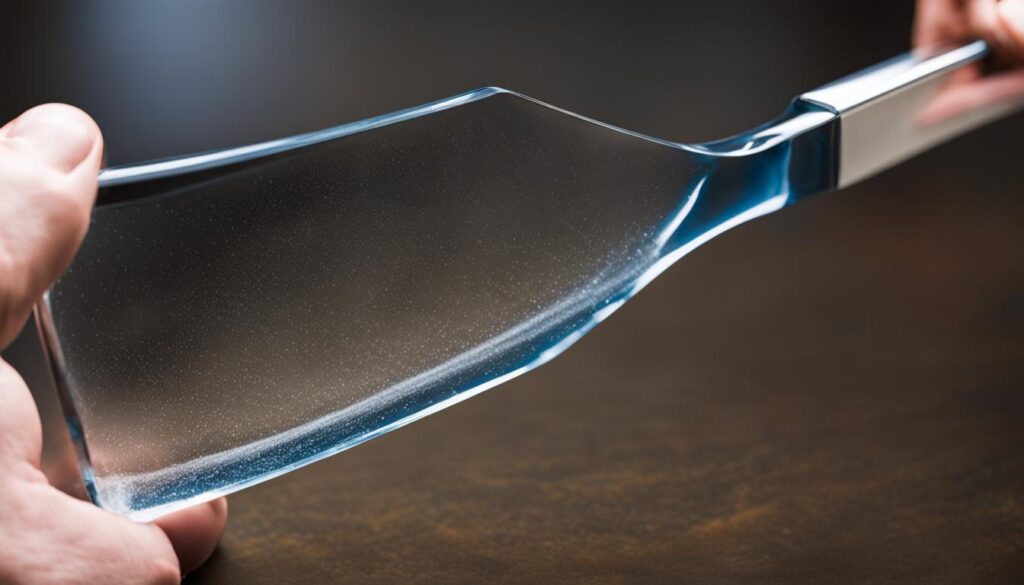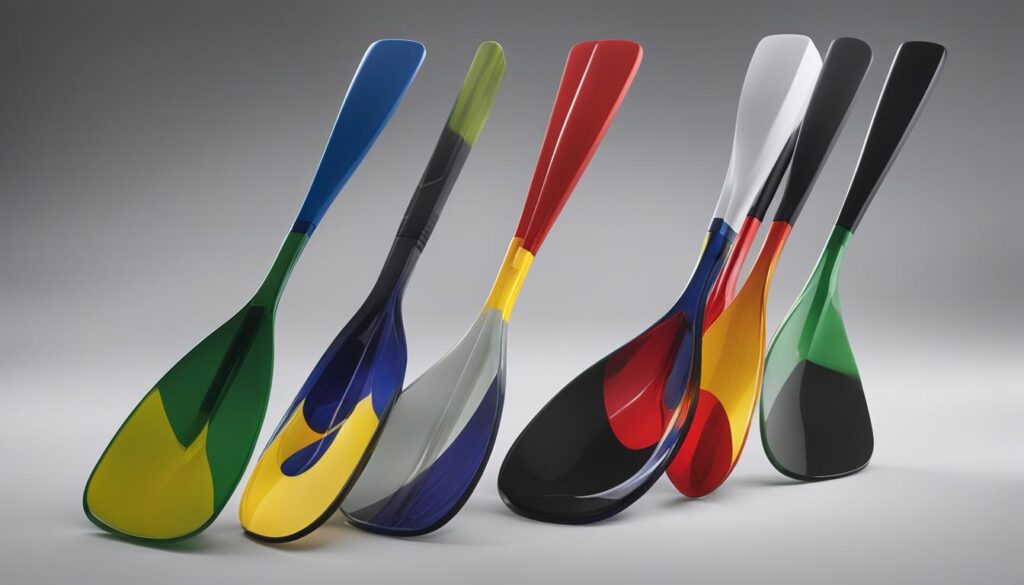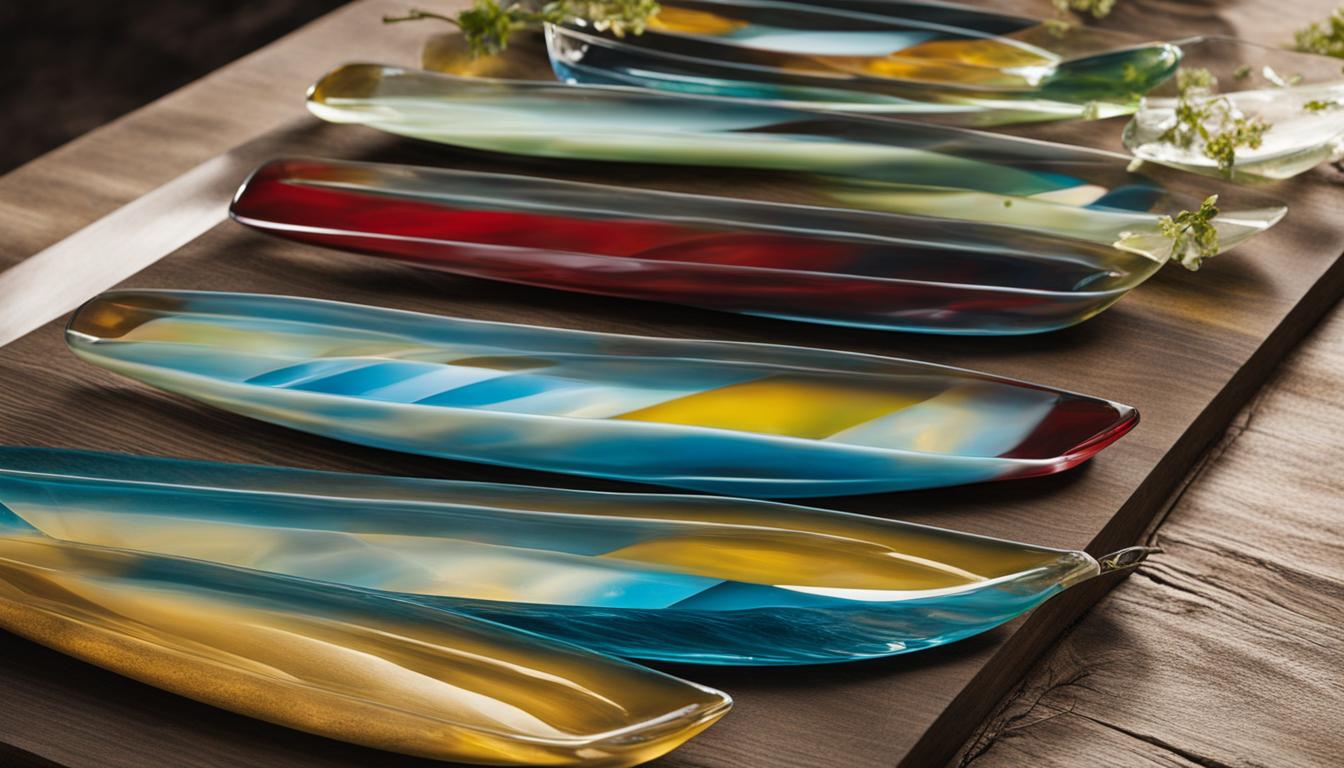When it comes to choosing the right kayak paddle, there are several factors to consider. One of the most important decisions you’ll need to make is whether to go for a glass paddle or a plastic paddle. Each material has its own set of pros and cons, and understanding them will help you make an informed decision.
Let’s dive into the details and compare the advantages and benefits of glass and plastic paddles. By understanding the differences between these two materials, you can choose the paddle that suits your needs and preferences.
Key Takeaways:
- Glass paddles offer increased durability and better performance.
- Plastic paddles are lightweight and more affordable.
- Glass paddles have superior energy transfer and controlled strokes.
- Plastic paddles are impact-resistant and suitable for recreational use.
- Glass paddles are more expensive, while plastic paddles are budget-friendly.
Advantages of Glass Paddles
Glass paddles offer several advantages over plastic paddles. One of the key advantages is their durability. Made from sturdy materials such as fiberglass or carbon fiber, glass paddles are designed to withstand the rigorous demands of paddling without easily breaking or deteriorating. This makes them a reliable choice for paddlers who value longevity and want a paddle that can withstand frequent use.
Another significant advantage of glass paddles is their performance. The rigid construction and high-quality materials used in glass paddles allow for efficient energy transfer during each stroke. This results in stronger and more controlled strokes, making glass paddles particularly suitable for experienced paddlers or those looking to enhance their paddling skills. The improved performance of glass paddles can lead to better speed, maneuverability, and overall paddling experience.

Table: Comparison of Glass and Plastic Paddles
| Advantages | Glass Paddles | Plastic Paddles |
|---|---|---|
| Durability | ✓ | – |
| Performance | ✓ | – |
| Weight | – | ✓ |
| Affordability | – | ✓ |
The table above highlights the advantages of glass paddles compared to plastic paddles. While glass paddles excel in terms of durability and performance, plastic paddles have their own benefits, such as being lightweight and more affordable.
“Glass paddles are known for their durability and performance, making them a reliable choice for experienced paddlers.”
It’s important to consider these advantages when choosing between glass and plastic paddles. If you prioritize durability and performance, a glass paddle is a great option. However, if you value affordability and lightweight design, a plastic paddle may be more suitable for your needs. Ultimately, the choice depends on your preferences and the type of paddling experience you seek.
Plastic Paddle Benefits
Plastic paddles offer several benefits that make them a popular choice for paddlers in various conditions. One notable advantage is their lightweight construction, which provides ease of handling and maneuverability in the water. The lighter weight of plastic paddles makes them particularly suitable for beginners or individuals who prefer a paddle that is easy to use and control. Whether you’re exploring calm lakes or navigating gentle rivers, the lightweight nature of plastic paddles ensures a comfortable and enjoyable paddling experience.
Another key benefit of plastic paddles is their affordability. Compared to glass paddles, which tend to be more expensive, plastic paddles offer a cost-effective solution for those on a budget. This affordability makes them accessible to a wide range of paddlers, including recreational enthusiasts and casual paddlers. You can enjoy the thrill of kayaking without breaking the bank by opting for a reliable and affordable plastic paddle.
Moreover, plastic paddles are well-suited for specific conditions, such as recreational kayaking or casual paddling in calm waters. Their durability and impact resistance allow them to withstand accidental bumps or collisions better than glass paddles. This makes plastic paddles a practical choice for those who engage in leisurely paddling activities or prefer a paddle that can endure occasional rough handling. While they may not offer the same level of performance as glass paddles, plastic paddles serve their purpose by providing reliable functionality in less demanding scenarios.
Table: Comparing Glass and Plastic Paddle Benefits
| Benefits | Glass Paddles | Plastic Paddles |
|---|---|---|
| Lightweight Design | ✓ | ✓ |
| Affordability | ✓ | |
| Durability | ✓ | ✓ |
| Performance | ✓ | |
| Impact Resistance | ✓ |
As the table above illustrates, glass paddles excel in terms of performance and durability, whereas plastic paddles shine in terms of affordability, impact resistance, and lightweight design. By considering your specific needs and the paddle characteristics that matter to you most, you can make an informed decision when choosing between glass and plastic paddles.
Performance Factors to Consider
When choosing between glass and plastic paddles, it’s important to take into account various performance factors. Glass paddles are known for their superior performance, while plastic paddles have their own advantages in terms of impact resistance. Let’s explore these factors in more detail.
Performance of Glass Paddles
Glass paddles offer exceptional performance due to their rigid construction and materials. The rigid nature of glass paddles allows for efficient energy transfer, resulting in stronger and more controlled strokes. This characteristic makes glass paddles an ideal choice for experienced paddlers or those looking to enhance their skills. The increased performance of glass paddles can greatly impact your overall paddling experience, allowing you to paddle with more power and precision.
Impact Resistance of Plastic Paddles
While plastic paddles may not offer the same level of performance as glass paddles, they do have an advantage when it comes to impact resistance. Plastic paddles are more resilient and can withstand accidental bumps or collisions better than glass paddles. This makes them a practical choice for paddlers who frequently navigate rocky or unpredictable waters. The impact resistance of plastic paddles ensures that they can endure the demands of challenging paddling conditions without easily breaking or cracking.
| Performance Factors | Glass Paddles | Plastic Paddles |
|---|---|---|
| Efficiency of Energy Transfer | High | Moderate |
| Stroke Control | Excellent | Good |
| Impact Resistance | Low | High |
Ultimately, the choice between glass and plastic paddles will depend on your specific needs and paddling style. If you prioritize enhanced performance and have the budget for a higher-quality paddle, glass paddles are a great option. However, if you frequently encounter challenging conditions and require a paddle that can withstand impacts, plastic paddles may be more suitable. Consider your paddling goals and the environments you navigate to make an informed decision that will enhance your overall paddling experience.
Cost Comparison
When it comes to choosing between glass and plastic paddles, one important factor to consider is the cost. Glass paddles, with their superior durability and performance advantages, tend to have a higher price tag compared to plastic paddles. While the initial investment may be higher, a glass paddle can be a worthwhile long-term investment for those seeking a paddle that will last.
On the other hand, plastic paddles are more affordable, making them a popular choice for beginners or those on a tight budget. They offer a cost-effective option without compromising on functionality. If budget is a key consideration for you, a plastic paddle may be the way to go.
To help you understand the cost differences between glass and plastic paddles, take a look at the table below:
| Paddle Material | Average Price Range |
|---|---|
| Glass | $200 – $500 |
| Plastic | $50 – $150 |
Keep in mind that these price ranges are estimates and can vary depending on the brand, quality, and features of the paddles. When making your decision, consider your budget and how much you’re willing to invest in a paddle that meets your needs.
Choosing the Right Paddle
When it comes to choosing the right paddle for your kayaking adventures, you’ll need to consider several factors, including the paddle material and your specific paddling conditions. Glass and plastic paddles each have their own advantages and are suited for different needs. Let’s explore the factors that can help you make an informed decision.
Glass Paddles
Glass paddles are known for their durability and superior performance. Made from materials like fiberglass or carbon fiber, glass paddles are built to withstand the rigors of paddling without easily breaking or deteriorating. Their sturdy construction ensures that you’ll have a reliable paddle that can handle various conditions.
If you prioritize performance and want a paddle that offers efficient energy transfer and controlled strokes, a glass paddle might be the ideal choice for you. The rigid nature of glass paddles allows for better power transmission, resulting in stronger and more controlled strokes. This can be especially beneficial for experienced paddlers who are looking to enhance their skills and achieve optimal performance on the water.
Plastic Paddles
Plastic paddles, on the other hand, have their own set of advantages that make them suitable for specific conditions and preferences. One major benefit of plastic paddles is their lightweight construction. This makes them easy to handle and maneuver, particularly for beginners or those who prefer a paddle that is easy to use and control.
In addition, plastic paddles tend to be more affordable compared to glass paddles, making them a cost-effective choice for those on a budget. They are also ideal for recreational kayaking or casual paddling in calm waters. If you’re looking for a paddle that is versatile, affordable, and lightweight, a plastic paddle might be the right fit for you.
Choosing the Right Paddle
When it comes to choosing between glass and plastic paddles, it’s important to consider your individual needs, preferences, and paddling goals. If durability and performance are your top priorities, and you’re willing to invest in a higher-quality paddle, a glass paddle might be the best choice for you. On the other hand, if affordability and lightweight design are what you value, and you’re looking for a paddle for recreational or casual use, a plastic paddle could be more suitable.
By assessing your specific paddling needs, skill level, and budget, you can make an informed decision and choose the right paddle that will enhance your kayaking experience. Remember to always consider the paddle material and how it aligns with your desired performance and paddling conditions. Happy paddling!

Conclusion
When it comes to choosing between glass and plastic paddles, you have several factors to consider. Glass paddles offer durability and high performance, but they come at a higher cost. On the other hand, plastic paddles are lightweight, affordable, and suitable for recreational use. It ultimately boils down to your personal preferences, budget, and paddling needs.
For those seeking a durable and high-performing paddle, a glass paddle would be a great choice. Its sturdy construction and efficient energy transfer make it ideal for experienced paddlers looking to enhance their skills. However, if affordability and ease of use are your priorities, a plastic paddle would be more suitable, especially for beginners or casual paddling in calm waters.
Consider your paddling goals, skill level, and budget before making a decision. Whether you go for glass or plastic, selecting the right paddle is crucial for an enjoyable paddling experience. So take your time, weigh the pros and cons, and choose the paddle that best suits your individual needs. Happy paddling!
FAQ
What are the advantages of glass paddles?
Glass paddles offer increased durability and better performance compared to plastic paddles.
Why are glass paddles more durable?
Glass paddles are typically made from sturdy materials like fiberglass or carbon fiber, ensuring they can withstand the rigors of paddling without easily breaking or deteriorating.
How do glass paddles provide better performance?
The rigid nature of glass paddles allows for more efficient energy transfer, resulting in stronger and more controlled strokes.
What are the benefits of plastic paddles?
Plastic paddles are lightweight and affordable, making them easy to handle and suitable for beginners or recreational use.
Why are plastic paddles lightweight?
Plastic paddles are constructed using lightweight materials, which make them easy to handle and maneuver in the water.
Are plastic paddles more affordable than glass paddles?
Yes, plastic paddles tend to be more affordable compared to glass paddles.
Which paddle material is better for high-performance paddling?
Glass paddles are known for their superior performance due to their rigidity and construction, making them ideal for experienced paddlers or those looking for high-performance paddles.
Are plastic paddles impact-resistant?
Plastic paddles are more impact-resistant compared to glass paddles, making them better able to withstand accidental bumps or collisions.
Are glass paddles worth the higher cost?
Glass paddles may be a worthwhile long-term investment for those looking for a durable and high-performing paddle, but it depends on individual budget and needs.
How do I choose the right paddle?
Consider your specific needs, preferences, paddling goals, skill level, and budget when choosing between glass and plastic paddles.





